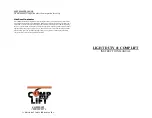
RISCHIO DI URTO
Dovuto alle parti del sollevatore o del veicolo posizionate ad altez-
za d’uomo.
Quando, per ragioni di lavoro, il sollevato-
re viene fermato a quote relativamente
basse (inferiori a 1,75 m dal suolo) vi è il
rischio di urtare contro le parti non eviden-
ziate da particolari colorazioni (Fig.28).
Fig.28
Rischio d’urto
RISCHIO DI SPOSTAMENTO DEL VEICOLO
Dovuto ad operazioni da compiere che generano spinte sul veico-
lo.
Se il veicolo é di dimensioni o pesi rag-
guardevoli uno spostamento può rappre-
sentare una situazione di sovraccarico o
sbilanciamento non previsto pertanto, pri-
ma del sollevamento e durante tutte le fasi
di lavoro,OCCORRE CHE IL VEICOLO
SIA BLOCCATO MEDIANTE IL FRENO A
MANO.
Fig.29
Rischio di spostamento
RISCHIO DI CADUTA DEL VEICOLO DAL PONTE
SOLLEVATORE
Che può essere causato dal posiziona-
mento non corretto del veicolo sulle peda-
ne,da un cattivo fissaggio del veicolo,o da
dimensioni del veicolo non compatibili col
sollevatore.
Fig.30
Rischio di caduta del veicolo
NON COMPIERE MAI PROVE COL VEICOLO IN
MOTO SULLE PEDANE (es. retromarce ecc.).
RISCHIO DI ALLENTAMENTO DELLE FUNI
Dovuto ad oggetti appoggiati alle colonne o lasciati in direzione
delle pedane (Fig.31).
NON LASCIARE OGGETTI APPOGGIATI ALLE
COLONNE O NELLA ZONA DI DISCESA DELLE
PARTI MOBILI.
Se vengono lasciati oggetti che inter-
feriscono con la discesa delle pedane
si ha il blocco della discesa.
Fig.31
Rischio di allentamento delle funi
RISK OF IMPACT
Caused by the parts of the lift or the vehicle that are positioned at
head height.
When, due to operational reasons, the lift
is stopped at relatively low elevations (less
than 1.75 m from the ground) personnel
must be careful to avoid impact with parts
of the machine not marked with special co-
lours (Fig.28).
Fig.28
Risk of impact
RISK OF VEHICLE MOVING
Caused by operations involving the application of force sufficient to
displace the vehicle.
In the case of large or particularly heavy
vehicles, sudden movement could create
an unacceptable overload or uneven
loadsharing. Therefore, before lifting the
vehicle and during all operations on the
vehicle
MAKE SURE THAT IT IS PROPERLY
STOPPED BY THE HAND BRAKE.
Fig.29
Risk of vehicle moving
RISK OF VEHICLE FALLING FROM LIFT
This hazard may arise in the case of incorrect positioning of the
vehicle on the platforms, incorrect stop-
ping of the vehicle, or in the case of vehi-
cles of dimensions that are not compatib-
le with the capacity of the lift.
Fig.30
Risk of vehicle falling
NEVER ATTEMPT TO PERFORM TESTS BY DRI-
VING THE VEHICLE WHILE IT IS ON THE PLAT-
FORMS (e.g. reversing, etc.).
RISK OF SLACKENING OF LIFT CABLES
Caused by objects left leaning against the posts or on the plat-
forms (fig.31).
NEVER LEAN OBJECTS AGAINST THE POSTS
OR LEAVE THEM IN THE LOWERING AREA OF
THE MOVABLE PARTS OF
THE LIFT.
If you leave objects that interfere with
the free lowering of the platforms the
lowering movement will be interrupted.
Fig.31
Risk of slackening of lift cables
20
Summary of Contents for 450AT
Page 1: ...I PONTE SOLLEVATORE A 4 COLONNE GB 4 POST LIFT 450N 450AT...
Page 2: ......
Page 42: ...COLONNE POSTS S ULEN COLONNES COLUMNAS...
Page 43: ...TRAVERSE CROSSBEAMS TRAVERSE TRAVERSES TRAVERSA OS...
Page 44: ...PEDANE PLATFORMS FAHRSCHIENE CHEMINS DE ROULEMENT PLATAFORMAS...
















































